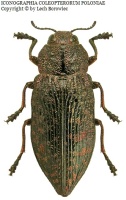Підтримуємо Вільну Україну
 We Support Free Ukraine
We Support Free Ukraine

Biodiversity Map
Taxa

Poecilonota — subordinate taxa:
Taxon count: 8
-
Poecilonota semenoviSet as tree root ↑
Show taxon data → → Show taxon data -
Poecilonota variolosa chinensisSet as tree root ↑
Show taxon data → → Show taxon data -
Poecilonota variolosa cupreomaculataSet as tree root ↑
Show taxon data → → Show taxon data -
Poecilonota variolosa dicercoidesSet as tree root ↑
Show taxon data → → Show taxon data -
Poecilonota variolosa populialbaeSet as tree root ↑
Show taxon data → → Show taxon data -
Poecilonota variolosa setulosaSet as tree root ↑
Show taxon data → [2] → Show taxon data -
Poecilonota variolosa variolosaSet as tree root ↑
Show taxon data → ⚑ [79] → Show taxon data
[79] → Show taxon data -
Poecilonota variolosa yanoiSet as tree root ↑
Show taxon data → → Show taxon data
-
Arthropodaphylum
Click to switch
to select orders
and filters > -
Hexapodasubphylum
Click to switch
to select orders
and filters > -
Insectaclass
Click to switch
to select orders
and filters > -
Coleopteraorder
Click to set
as the main taxon
and as a base
← of the left panel > -
Polyphagasuborder
Click to set
as the main taxon
and as a base
← of the left panel > -
Elateriformiaseries
Click to set
as the main taxon
and as a base
← of the left panel > -
Buprestoideasuperfamily
Click to set
as the main taxon
and as a base
← of the left panel > -
Buprestidaefamily
Click to set
as the main taxon
and as a base
← of the left panel > -
Chrysochroinaesubfamily
Click to set
as the main taxon
and as a base
← of the left panel > -
Poecilonotinitribe
Click to set
as the main taxon
and as a base
← of the left panel > -
Poecilonotagenus
Click to set
as the main taxon
and as a base
← of the left panel > -
Poecilonota variolosaspecies
Click to set
as the main taxon
and as a base
← of the left panel >
PL
YES
name status: valid name
BioMap ID: 1014110
taxon code: 2670
taxonomy checked: YES
Data on distribution in Poland

Statistics
- Records: 79
- Publications: 28
- Collections: 8
- Publication authors: 26
- Illustrations (iconography): 1
- Photos (specimen/observation): lacking
Taxon description
Gatunek rozprzestrzeniony w niemal całej Europie z wyjątkiem obszaru nadatlantyckiego, wykazywany ponadto z zachodniej części Afryki Północnej oraz z Syberii i Zabajkala, przy tym w miarę posuwania się ze wschodu na zachód coraz rzadziej spotykany. W Polsce znany z nielicznych stanowisk, a większość danych o rozmieszczeniu oparta jest na znaleziskach z ubiegłego stulecia. Larwy żyją w topolach, zwłaszcza w osice — Populus tremula L.; żerują one w pniach, głównie po stronie nasłonecznionej, gdzie wygryzają chodnik w łyku, a gdy kora jest cienka, wdrążają się w drewno, ale przepoczwarczają się zawsze blisko zewnętrznej powierzchni drewna. Cykl rozwojowy co najmniej dwuletni. Postacie dojrzałe pojawiają się w czerwcu i przeżywają do sierpnia, a w górach spotyka się je jeszcze we wrześniu. Chrząszcz ten jest notowany jako szkodnik, ale z uwagi na wielką rzadkość występowania nie ma większego znaczenia w gospodarce leśnej.
Illustrations
... browse
 Poecilonota
Poecilonotavariolosa
variolosa
External data sources
- Ostatnie rekordy
-
1111112
 ⊡
⊡ Buprestidae: Poecilonota variolosa variolosa, GR, Vrasna, UTM GL20, 2006, leg. A. Wrzecionko
Buprestidae: Poecilonota variolosa variolosa, GR, Vrasna, UTM GL20, 2006, leg. A. Wrzecionko -
1011340
 ×
× Buprestidae: Poecilonota variolosa variolosa, 1935, coll. MiIZ PAN: Tenenbaum Sz.
Buprestidae: Poecilonota variolosa variolosa, 1935, coll. MiIZ PAN: Tenenbaum Sz. -
1011339
 ×
× Buprestidae: Poecilonota variolosa variolosa, 1935, coll. MiIZ PAN: Tenenbaum Sz.
Buprestidae: Poecilonota variolosa variolosa, 1935, coll. MiIZ PAN: Tenenbaum Sz. -
1011338
 ×
× Buprestidae: Poecilonota variolosa variolosa, 1935, coll. MiIZ PAN: Tenenbaum Sz.
Buprestidae: Poecilonota variolosa variolosa, 1935, coll. MiIZ PAN: Tenenbaum Sz. -
1011337
 ×
× Buprestidae: Poecilonota variolosa variolosa, [brak danych], coll. MiIZ PAN: Tenenbaum Sz.
Buprestidae: Poecilonota variolosa variolosa, [brak danych], coll. MiIZ PAN: Tenenbaum Sz. -
1011336
 ×
× Buprestidae: Poecilonota variolosa variolosa, Austria, coll. MiIZ PAN: Tenenbaum Sz.
Buprestidae: Poecilonota variolosa variolosa, Austria, coll. MiIZ PAN: Tenenbaum Sz. -
1011335
 ×
× Buprestidae: Poecilonota variolosa variolosa, Austria, coll. MiIZ PAN: Tenenbaum Sz.
Buprestidae: Poecilonota variolosa variolosa, Austria, coll. MiIZ PAN: Tenenbaum Sz. -
1011334
 ×
× Buprestidae: Poecilonota variolosa variolosa, Wołyń, coll. MiIZ PAN: Tenenbaum Sz.
Buprestidae: Poecilonota variolosa variolosa, Wołyń, coll. MiIZ PAN: Tenenbaum Sz. -
771968
 ×
× Buprestidae: Poecilonota variolosa variolosa, PL, Leśna ad Baranowicze, 1935, coll. Uniw. Wrocławski, ZBiTE
Buprestidae: Poecilonota variolosa variolosa, PL, Leśna ad Baranowicze, 1935, coll. Uniw. Wrocławski, ZBiTE -
767490
 ⊡
⊡ Buprestidae: Poecilonota variolosa variolosa, PL, Wyżyna Małopolska, Puszcza Kozienicka, rez. Jedlnia nature reserve, UTM EB29, 2006, leg. M. Miłkowski (Gutowski et Miłkowski 2008)
Buprestidae: Poecilonota variolosa variolosa, PL, Wyżyna Małopolska, Puszcza Kozienicka, rez. Jedlnia nature reserve, UTM EB29, 2006, leg. M. Miłkowski (Gutowski et Miłkowski 2008) - ... more
- Powiązane publikacje
-
Gutowski J.M. 2010b. Nowe i interesujące gatunki bogatkowatych (Coleoptera: Buprestidae) w faunie Puszczy Białowieskiej. Wiad. Entomol., 29(3):212-214 [530].
 full text
full text Show records
Show records -
Gutowski J.M., Miłkowski M. 2008. Bogatkowate (Coleoptera: Buprestidae) Puszczy Kozienickiej. [Buprestidae (Coleoptera) of the Kozienicka Forest.]. Parki Nar. Rez. Przyr., 27(2):49-85.
 Show records
Show records -
Wełnicki M. 2001(2000). Nowe stanowiska rzadkich gatunków Cerambycidae i Buprestidae (Coleoptera) w Polsce. Wiad. Entomol., 19(3-4):193-194 [264].
 full text
full text Show records
Show records -
Burakowski B., Mroczkowski M., Stefańska J. 1985. Chrząszcze – Coleoptera. Buprestoidea, Elateroidea i Cantharoidea. Katalog Fauny Polski, XXIII, 10, Warszawa.
 Show records
Show records -
Horion A. 1955a. Faunistik der mitteleuropäischen Käfer. Band IV: Sternoxia (Buprestidae), Fossipedes, Macrodactylia, Brachymera. Ent. Arb. Mus. Frey, , Tutzing.
 Show records
Show records - ... more




